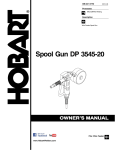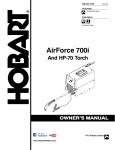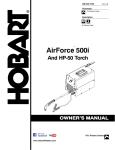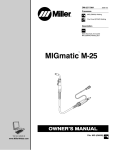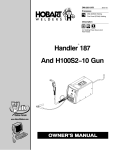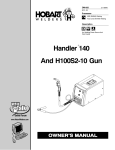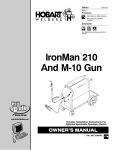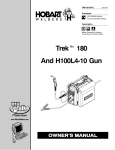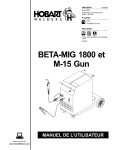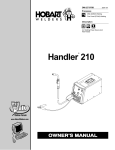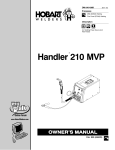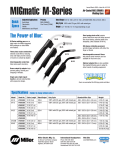Download H100S2−10 Gun - Hobart Welders
Transcript
OM-245 986B 2012−05 Processes MIG (GMAW) Welding Flux Cored (FCAW) Welding Description Semi-Automatic Air-Cooled MIG (GTAW) Welding Gun H100S2−10 Gun File: MIG (GMAW) www.HobartWelders.com TABLE OF CONTENTS SECTION 1 −SAFETY PRECAUTIONS FOR GMAW WELDING GUNS − READ BEFORE USING . . . . . . 1 1-1. Symbol Usage . . . . . . . . . . . . . . . . . . . . . . . . . . . . . . . . . . . . . . . . . . . . . . . . . . . . . . . . . . . . . . . . . 1 1-2. Arc Welding Hazards . . . . . . . . . . . . . . . . . . . . . . . . . . . . . . . . . . . . . . . . . . . . . . . . . . . . . . . . . . . . 1 1-3. Proposition 65 Warnings . . . . . . . . . . . . . . . . . . . . . . . . . . . . . . . . . . . . . . . . . . . . . . . . . . . . . . . . . 2 1-4. Principal Safety Standards . . . . . . . . . . . . . . . . . . . . . . . . . . . . . . . . . . . . . . . . . . . . . . . . . . . . . . . 2 1-5. EMF Information . . . . . . . . . . . . . . . . . . . . . . . . . . . . . . . . . . . . . . . . . . . . . . . . . . . . . . . . . . . . . . . . 2 SECTION 2 − MESURES DE SÉCURITÉ VISANT LES PISTOLETS DE SOUDAGE GMAW − À LIRE AVANT UTILISATION . . . . . . . . . . . . . . . . . . . . . . . . . . . . . . . . . . . . . . . . . . . . . . . . . . . . . . . . . . . . . . . . . . . . . . . . . . . . . . 3 2-1. Signification des symboles . . . . . . . . . . . . . . . . . . . . . . . . . . . . . . . . . . . . . . . . . . . . . . . . . . . . . . . 3 2-2. Dangers relatifs au soudage à l’arc . . . . . . . . . . . . . . . . . . . . . . . . . . . . . . . . . . . . . . . . . . . . . . . . 3 2-3. Proposition californienne 65 Avertissements . . . . . . . . . . . . . . . . . . . . . . . . . . . . . . . . . . . . . . . . . 4 2-4. Principales normes de sécurité . . . . . . . . . . . . . . . . . . . . . . . . . . . . . . . . . . . . . . . . . . . . . . . . . . . . 4 2-5. Informations relatives aux CEM . . . . . . . . . . . . . . . . . . . . . . . . . . . . . . . . . . . . . . . . . . . . . . . . . . . 4 SECTION 3 − INSTALLATION . . . . . . . . . . . . . . . . . . . . . . . . . . . . . . . . . . . . . . . . . . . . . . . . . . . . . . . . . . . . . . . . 5 3-1. Specifications . . . . . . . . . . . . . . . . . . . . . . . . . . . . . . . . . . . . . . . . . . . . . . . . . . . . . . . . . . . . . . . . . . 5 3-2. Duty Cycle And Overheating . . . . . . . . . . . . . . . . . . . . . . . . . . . . . . . . . . . . . . . . . . . . . . . . . . . . . . 5 3-3. Installing Gun . . . . . . . . . . . . . . . . . . . . . . . . . . . . . . . . . . . . . . . . . . . . . . . . . . . . . . . . . . . . . . . . . . 6 SECTION 4 − OPERATION . . . . . . . . . . . . . . . . . . . . . . . . . . . . . . . . . . . . . . . . . . . . . . . . . . . . . . . . . . . . . . . . . . 6 4-1. Operating The Gun . . . . . . . . . . . . . . . . . . . . . . . . . . . . . . . . . . . . . . . . . . . . . . . . . . . . . . . . . . . . . . 6 SECTION 5 − MAINTENANCE & TROUBLESHOOTING . . . . . . . . . . . . . . . . . . . . . . . . . . . . . . . . . . . . . . . . . 7 5-1. Removing Nozzle, Contact Tip, And Adapter, Changing Liner, And Cleaning Gun Casing . . . 7 5-2. Replacing Switch And/Or Head Tube . . . . . . . . . . . . . . . . . . . . . . . . . . . . . . . . . . . . . . . . . . . . . . . 8 5-3. Routine Maintenance . . . . . . . . . . . . . . . . . . . . . . . . . . . . . . . . . . . . . . . . . . . . . . . . . . . . . . . . . . . . 9 5-4. Troubleshooting . . . . . . . . . . . . . . . . . . . . . . . . . . . . . . . . . . . . . . . . . . . . . . . . . . . . . . . . . . . . . . . . 9 SECTION 6 − PARTS LIST . . . . . . . . . . . . . . . . . . . . . . . . . . . . . . . . . . . . . . . . . . . . . . . . . . . . . . . . . . . . . . . . . . . 10 WARRANTY Hobart is registered to the ISO 9001 Quality System Standard. SECTION 1 −SAFETY PRECAUTIONS FOR GMAW WELDING GUNS − READ BEFORE USING SR7 (MIG) 2011-10 Protect yourself and others from injury — read, follow, and save these important safety precautions and operating instructions. 1-1. Symbol Usage DANGER! − Indicates a hazardous situation which, if not avoided, will result in death or serious injury. The possible hazards are shown in the adjoining symbols or explained in the text. Indicates a hazardous situation which, if not avoided, could result in death or serious injury. The possible hazards are shown in the adjoining symbols or explained in the text. NOTICE − Indicates statements not related to personal injury. . Indicates special instructions. This group of symbols means Warning! Watch Out! ELECTRIC SHOCK, MOVING PARTS, and HOT PARTS hazards. Consult symbols and related instructions below for necessary actions to avoid the hazards. 1-2. Arc Welding Hazards The symbols shown below are used throughout this manual to call attention to and identify possible hazards. When you see the symbol, watch out, and follow the related instructions to avoid the hazard. The safety information given below is only a summary of the more complete safety information found in the welding power source Owner’s Manual. Read and follow all Safety Standards. Only qualified persons should install, operate, maintain, and repair this unit. During operation, keep everybody, especially children, away. ELECTRIC SHOCK can kill. D Always wear dry insulating gloves. D Insulate yourself from work and ground. D Do not touch live electrode or electrical parts. D Repair or replace worn, damaged, or cracked gun or cable insulation. D Turn off welding power source before changing contact tip or gun parts. D Keep all covers and handle securely in place. FUMES AND GASES can be hazardous. D Keep your head out of the fumes. D Ventilate area, or use breathing device. D Read Material Safety Data Sheets (MSDSs) and manufacturer’s instructions for material used. WELDING can cause fire or explosion. D Do not weld near flammable material. D Do not weld on containers that have held combustibles, or on closed containers such as tanks, drums, or pipes unless they are properly prepared according to AWS F4.1 and AWS A6.0 (see Safety Standards). D Watch for fire; keep extinguisher nearby. BUILDUP OF GAS can injure or kill. D Shut off compressed gas supply when not in use. D Always ventilate confined spaces or use approved air-supplied respirator. MOVING PARTS can injure. D Keep away from moving parts. D Keep away from pinch points such as drive rolls. ARC RAYS can burn eyes and skin. D Wear welding helmet with correct shade of filter. D Wear correct eye and body protection. D Cover exposed skin with spatter-resistant clothing. HOT PARTS can burn. D Allow gun to cool before touching. D Do not touch hot metal. D Protect hot metal from contact by others. NOISE can damage hearing. Noise from some processes or equipment can damage hearing. D Check for noise level limits exceeding those specified by OSHA. D Use approved ear plugs or ear muffs if noise level is high. D Warn others nearby about noise hazard. WELDING WIRE can injure. D Keep hands and body away from gun tip when trigger is pressed. READ INSTRUCTIONS. D Read and follow all labels and the Owner’s Manual carefully before installing, operating, or servicing unit. Read the safety information at the beginning of the manual and in each section. D Use only genuine replacement parts from the manufacturer. D Perform maintenance and service according to the Owner’s Manuals, industry standards, and national, state, and local codes. OM-245 986 Page 1 1-3. Proposition 65 Warnings Welding or cutting equipment produces fumes or gases which contain chemicals known to the State of California to cause birth defects and, in some cases, cancer. (California Health & Safety Code Section 25249.5 et seq.) This product contains chemicals, including lead, known to the state of California to cause cancer, birth defects, or other reproductive harm. Wash hands after use. 1-4. Principal Safety Standards Safety in Welding, Cutting, and Allied Processes, ANSI Standard Z49.1, is available as a free download from the American Welding Society at http://www.aws.org or purchased from Global Engineering Documents (phone: 1-877-413-5184, website: www.global.ihs.com). Safe Practice For Occupational And Educational Eye And Face Protection, ANSI Standard Z87.1, from American National Standards Institute, 25 West 43rd Street, New York, NY 10036 (phone: 212-642-4900, website: www.ansi.org). Safe Practices for the Preparation of Containers and Piping for Welding and Cutting, American Welding Society Standard AWS F4.1, from Global Engineering Documents (phone: 1-877-413-5184, website: www.global.ihs.com). Safe Practices for Welding and Cutting Containers that have Held Combustibles, American Welding Society Standard AWS A6.0, from Global Engineering Documents (phone: 1-877-413-5184, website: www.global.ihs.com). National Electrical Code, NFPA Standard 70, from National Fire Protection Association, Quincy, MA 02269 (phone: 1-800-344-3555, website: www.nfpa.org and www. sparky.org). Safe Handling of Compressed Gases in Cylinders, CGA Pamphlet P-1, from Compressed Gas Association, 14501 George Carter Way, Suite 103, Chantilly, VA 20151 (phone: 703-788-2700, website: www.cganet.com). Safety in Welding, Cutting, and Allied Processes, CSA Standard W117.2, from Canadian Standards Association, Standards Sales, 5060 Spectrum Way, Suite 100, Ontario, Canada L4W 5NS (phone: 800-463-6727, website: www.csa-international.org). Safe Practice For Occupational And Educational Eye And Face Protection, ANSI Standard Z87.1, from American National Standards Institute, 25 West 43rd Street, New York, NY 10036 (phone: 212-642-4900, website: www.ansi.org). Standard for Fire Prevention During Welding, Cutting, and Other Hot Work, NFPA Standard 51B, from National Fire Protection Association, Quincy, MA 02269 (phone: 1-800-344-3555, website: www.nfpa.org. OSHA, Occupational Safety and Health Standards for General Industry, Title 29, Code of Federal Regulations (CFR), Part 1910, Subpart Q, and Part 1926, Subpart J, from U.S. Government Printing Office, Superintendent of Documents, P.O. Box 371954, Pittsburgh, PA 15250-7954 (phone: 1-866-512-1800) (there are 10 OSHA Regional Offices— phone for Region 5, Chicago, is 312-353-2220, website: www.osha.gov). 1-5. EMF Information Electric current flowing through any conductor causes localized electric and magnetic fields (EMF). Welding current creates an EMF field around the welding circuit and welding equipment. EMF fields may interfere with some medical implants, e.g. pacemakers. Protective measures for persons wearing medical implants have to be taken. For example, restrict access for passers−by or conduct individual risk assessment for welders. All welders should use the following procedures in order to minimize exposure to EMF fields from the welding circuit: 1. Keep cables close together by twisting or taping them, or using a cable cover. 2. Do not place your body between welding cables. Arrange cables to one side and away from the operator. 3. Do not coil or drape cables around your body. OM-245 986 Page 2 4. Keep head and trunk as far away from the equipment in the welding circuit as possible. 5. Connect work clamp to workpiece as close to the weld as possible. 6. Do not work next to, sit or lean on the welding power source. 7. Do not weld whilst carrying the welding power source or wire feeder. About Implanted Medical Devices: Implanted Medical Device wearers should consult their doctor and the device manufacturer before performing or going near arc welding, spot welding, gouging, plasma arc cutting, or induction heating operations. If cleared by your doctor, then following the above procedures is recommended. SECTION 2 − MESURES DE SÉCURITÉ VISANT LES PISTOLETS DE SOUDAGE GMAW − À LIRE AVANT UTILISATION SR7(MIG)_2011−10fre Pour écarter les risques de blessure pour vous−même et pour autrui — lire, appliquer et ranger en lieu sûr ces consignes relatives aux précautions de sécurité et au mode opératoire. 2-1. Signification des symboles DANGER! − Indique une situation dangereuse qui si on l’évite pas peut donner la mort ou des blessures graves. Les dangers possibles sont montrés par les symboles joints ou sont expliqués dans le texte. Indique une situation dangereuse qui si on l’évite pas peut donner la mort ou des blessures graves. Les dangers possibles sont montrés par les symboles joints ou sont expliqués dans le texte. NOTE − Indique des déclarations pas en relation avec des blessures personnelles. . Indique des instructions spécifiques. Ce groupe de symboles veut dire Avertissement! Attention! DANGER DE CHOC ELECTRIQUE, PIECES EN MOUVEMENT, et PIECES CHAUDES. Consulter les symboles et les instructions ci-dessous y afférant pour les actions nécessaires afin d’éviter le danger. 2-2. Dangers relatifs au soudage à l’arc Les symboles présentés ci-après sont utilisés tout au long du présent manuel pour attirer votre attention et identifier les risques de danger. Lorsque vous voyez un symbole, soyez vigilant et suivez les directives mentionnées afin d’éviter tout danger. Les consignes de sécurité présentées ci-après ne font que résumer l’information contenue dans les normes de sécurité énumérées dans le manuel d’utilisation du poste de soudage. Veuillez lire et respecter toutes ces normes de sécurité. L’installation, l’utilisation, l’entretien et les réparations ne doivent être confiés qu’à des personnes qualifiées. Au cours de l’utilisation, tenir toute personne à l’écart et plus particulièrement les enfants. UN CHOC ÉLECTRIQUE peut tuer. D Porter toujours des gants secs et isolants. D S’isoler de la pièce et de la terre. D Ne jamais toucher une électrode ou des pièces électriques sous tension. D Réparer ou remplacer un pistolet ou la gaine d’isolement d’un câble usée, endommagée ou fissurée. D Mettre la soudeuse hors tension avant de remplacer un bec contact ou des pièces de pistolet. D S’assurer que tous les couvercles et poignées sont fermement assujettis. LE SOUDAGE peut causer un incendie ou une explosion. D Ne pas souder à proximité de matériaux inflammables. D Ne pas effectuer le soudage sur des conteneurs fermés tels que des réservoirs, tambours, ou conduites, à moins qu’ils n’aient été préparés correctement conformément à AWS F4.1 et AWS A6.0 (voir les Normes de Sécurité). D Prendre garde aux incendies et toujours avoir un extincteur à proximité. L’ACCUMULATION DE VAPEURS peut causer des lésions ou la mort. D Quand on n’utilise pas le gaz comprimé de protection, fermer le robinet de la bouteille. D Assurer toujours la ventilation des zones fermées ou utiliser un appareil respiratoire avec alimentation en air. Les PIÈCES MOBILES peuvent causer des blessures. D Ne pas s’approcher des organes mobiles. D Ne pas s’approcher des points de coincement tels que des rouleaux de commande. LES VAPEURS ET LES FUMÉES peuvent être nocives. LE RAYONNEMENT DE L’ARC peut brûler les yeux et la peau. D Éloigner sa tête des endroits renfermant des vapeurs. D Aérer la zone de travail ou porter un appareil respiratoire. D Consulter les fiches toxicologiques (MSDS) et les notices du fabricant de chaque matériel utilisé. D Porter un casque de soudage muni d’un filtre de protection oculaire approprié. D Porter une protection oculaire et des vêtements de protection appropriés. D Protéger la peau nue en portant des vêtements anti-éclaboussures. OM-245 986 Page 3 LES PIÈCES CHAUDES peuvent provoquer des brûlures. LES FILS DE SOUDAGE peuvent provoquer des blessures. D Laisser refroidir le pistolet avant de le toucher. D Ne pas toucher d’objets métalliques chauds. D Abriter les objets métalliques contre tout contact par les personnes à proximité. D Éloigner les mains et le corps de la buse du pistolet après avoir appuyé sur la gâchette. LIRE LES INSTRUCTIONS. Le BRUIT peut endommager l’ouie. D Lire et appliquer les instructions sur les étiquettes et le Mode d’emploi avant l’installation, l’utilisation ou l’entretien de l’appareil. Lire les informations de sécurité au début du manuel et dans chaque section. D N’utiliser que les pièces de rechange recommandées par le constructeur. D Effectuer l’entretien en respectant les manuels d’utilisation, les normes industrielles et les codes nationaux, d’état et locaux. Le bruit des processus et des équipements peut affecter l’ouïe. D Vérifier si les niveaux de bruit excèdent les limites spécifiées par l’OSHA. D Utiliser des bouche-oreilles ou des serre-tête antibruit approuvés si le niveau de bruit est élevé. D Avertir les personnes à proximité au sujet du danger inhérent au bruit. 2-3. Proposition californienne 65 Avertissements Les équipements de soudage et de coupage produisent des fumées et des gaz qui contiennent des produits chimiques dont l’État de Californie reconnaît qu’ils provoquent des malformations congénitales et, dans certains cas, des cancers. (Code de santé et de sécurité de Californie, chapitre 25249.5 et suivants) Ce produit contient des éléments chimiques, dont le plomb, reconnus par l’État de Californie pour leur caractère cancérogène ainsi que provoquant des malformations congénitales ou autres problèmes de procréation. Se laver les mains après toute manipulation. 2-4. Principales normes de sécurité Safety in Welding, Cutting, and Allied Processes, ANSI Standard Z49.1, is available as a free download from the American Welding Society at http://www.aws.org or purchased from Global Engineering Documents (phone: 1-877-413-5184, website: www.global.ihs.com). Safe Practice For Occupational And Educational Eye And Face Protection, ANSI Standard Z87.1, from American National Standards Institute, 25 West 43rd Street, New York, NY 10036 (phone: 212-642-4900, website: www.ansi.org). Safe Practices for the Preparation of Containers and Piping for Welding and Cutting, American Welding Society Standard AWS F4.1, from Global Engineering Documents (phone: 1-877-413-5184, website: www.global.ihs.com). Safe Practices for Welding and Cutting Containers that have Held Combustibles, American Welding Society Standard AWS A6.0, from Global Engineering Documents (phone: 1-877-413-5184, website: www.global.ihs.com). National Electrical Code, NFPA Standard 70, from National Fire Protection Association, Quincy, MA 02269 (phone: 1-800-344-3555, website: www.nfpa.org and www. sparky.org). Safe Handling of Compressed Gases in Cylinders, CGA Pamphlet P-1, from Compressed Gas Association, 14501 George Carter Way, Suite 103, Chantilly, VA 20151 (phone: 703-788-2700, website: www.cganet.com). Safety in Welding, Cutting, and Allied Processes, CSA Standard W117.2, from Canadian Standards Association, Standards Sales, 5060 Spectrum Way, Suite 100, Ontario, Canada L4W 5NS (phone: 800-463-6727, website: www.csa-international.org). Safe Practice For Occupational And Educational Eye And Face Protection, ANSI Standard Z87.1, from American National Standards Institute, 25 West 43rd Street, New York, NY 10036 (phone: 212-642-4900, website: www.ansi.org). Standard for Fire Prevention During Welding, Cutting, and Other Hot Work, NFPA Standard 51B, from National Fire Protection Association, Quincy, MA 02269 (phone: 1-800-344-3555, website: www.nfpa.org. OSHA, Occupational Safety and Health Standards for General Industry, Title 29, Code of Federal Regulations (CFR), Part 1910, Subpart Q, and Part 1926, Subpart J, from U.S. Government Printing Office, Superintendent of Documents, P.O. Box 371954, Pittsburgh, PA 15250-7954 (phone: 1-866-512-1800) (there are 10 OSHA Regional Offices— phone for Region 5, Chicago, is 312-353-2220, website: www.osha.gov). 2-5. Informations relatives aux CEM Le courant électrique qui traverse tout conducteur génère des champs électromagnétiques (CEM) à certains endroits. Le courant de soudage crée un CEM autour du circuit et du matériel de soudage. Les CEM peuvent créer des interférences avec certains implants médicaux comme des stimulateurs cardiaques. Des mesures de protection pour les porteurs d’implants médicaux doivent être prises: Limiter par exemple tout accès aux passants ou procéder à une évaluation des risques individuels pour les soudeurs. Tous les soudeurs doivent appliquer les procédures suivantes pour minimiser l’exposition aux CEM provenant du circuit de soudage: 4 Maintenir la tête et le torse aussi loin que possible du matériel du circuit de soudage. 5 Connecter la pince sur la pièce aussi près que possible de la soudure. 6 Ne pas travailler à proximité d’une source de soudage, ni s’asseoir ou se pencher dessus. 7 Ne pas souder tout en portant la source de soudage ou le dévidoir. 1 Rassembler les câbles en les torsadant ou en les attachant avec du ruban adhésif ou avec une housse. En ce qui concerne les implants médicaux : 2 Ne pas se tenir au milieu des câbles de soudage. Disposer les câbles d’un côté et à distance de l’opérateur. 3 Ne pas courber et ne pas entourer les câbles autour de votre corps. OM-245 986 Page 4 Les porteurs d’implants doivent d’abord consulter leur médecin avant de s’approcher des opérations de soudage à l’arc, de soudage par points, de gougeage, du coupage plasma ou de chauffage par induction. Si le médecin approuve, il est recommandé de suivre les procédures précédentes. SECTION 3 − INSTALLATION 3-1. Specifications Air-Cooled Welding Gun For GMAW And FCAW Welding Note: Using gasless flux cored wire reduces gun duty cycle. H100S2-10 Feeds .023 To .045 in. (0.6 To 1.1 mm) Hard Or Flux Cored Wires Duty Cycle Rating: 100%: 100 A With CO2 Shielding Gas 60%: 100 A With Mixed Gases Weight With 10 ft (3 m) Power Cable: 3.5 lb (1.6 kg) Ref. 246 668-A 3-2. Duty Cycle And Overheating . See Section 3-1. Specifications for amperage rating and duty cycle. .023 To .045 in. (0.6 To 1.1 mm) Hard Or Flux Cored Wires Definition 0 10 Minutes 100% Duty Cycle At 100 Amperes Using CO2 Duty Cycle is percentage of 10 minutes that gun can weld at rated load without overheating. NOTICE − Exceeding duty cycle can damage unit and void warranty. .023 To .045 in. (0.6 To 1.1 mm) Hard Or Flux Cored Wires 60% Duty Cycle At 100 Amperes Using Mixed Gases 6 Minutes Welding Continuous Welding 4 Minutes Resting Overheating A or V 0 15 Minutes OR Reduce Duty Cycle sduty1 5/95 OM-245 986 Page 5 3-3. Installing Gun 1 2 Gun Securing Knob Gun End Loosen knob. Insert gun end until it bottoms against drive assembly. Tighten knob. 3 Friction Terminals Connect friction terminals to gun trigger terminals inside unit. See power source manual for threading procedure. 1 3 2 243 861-A SECTION 4 − OPERATION 4-1. Operating The Gun 1 Trigger Switch When pressed, energized wire feeds and shielding gas flows. 1 Ref. 246 668-A OM-245 986 Page 6 SECTION 5 − MAINTENANCE & TROUBLESHOOTING 5-1. Removing Nozzle, Contact Tip, And Adapter, Changing Liner, And Cleaning Gun Casing 2 3 Head Tube ! Turn off welding source/wire feeder. 1 Nozzle 2 Contact Tip 3 Tip Adapter power . Wire size stamped on tip − check 1 and match wire size. Cut off wire and disconnect gun from feeder. 8 mm Remove nozzle, contact tip, and adapter. Unscrew and remove liner. Blow out gun casing. Lay gun cable out straight before installing new liner. 10 mm Reassemble gun in reverse order from taking it apart. Install Liner 5/8 in. (16 mm) Liner Stickout . Thread wire according to welding power source/wire feeder manual. Tools Needed: 8 mm, 10 mm 246 669-A OM-245 986 Page 7 5-2. Replacing Switch And/Or Head Tube ! Turn Off welding power source /wire feeder and disconnect gun. 1 Remove screws (5) and nuts (4). 2 Remove handle halves. 3 Remove switch housing. Install new switch and connect leads (polarity is not important). Reassemble in reverse order. If replacing head tube, continue to end of figure. Remove screw on opposite side. 4 Secure head tube in vice. 5 6 8 Loosen jam nut. Remove from vice and turn head tube out by hand. 7 Hand-tighten head tube into cable connector. Remove from vice. Reposition handle halves, and install switch housing. 9 Reinstall screws and nuts. Reinstall screw on opposite side. Tools Needed: phillips OM-245 986 Page 8 Place head tube in vice and tighten until nuts are tight. 15 mm 243 840-A 5-3. Routine Maintenance ! n = Check Z = Change ~ = Clean * To be done by Factory Authorized Service Agent Disconnect power before maintaining. . Maintain more often during severe conditions. l = Replace Reference Each Spool Of Wire n~ Nozzle and contact tip ~ Blow out gun casing l Unreadable Labels l Damaged Gas Hose Every 3 Months nl Cords nl Cracked Parts 5-4. Troubleshooting Trouble Remedy Wire does not feed; wire is not ener- Check contact tip. Check for kinks in gun cable and liner. gized; wire feeds unevenly. Check gun trigger plug connection at welding power source/wire feeder. Check, and if necessary, replace gun trigger switch (see Section 5-2). Check contact tip. Check for kinks in gun cable. Blow out liner and gun casing (see Section 5-1). Weld porosity. Remove weld spatter buildup in nozzle. Check O-rings on gun connector and replace if damaged. Make sure inner head tube is tight in cable connector. Check gun connector to be sure it is fully inserted into drive assembly. Check shielding gas flow/supply. Wire feeding stops or does not feed Straighten gun cable and/or replace damaged parts (see Section 5-1). properly during welding. Adjust drive roll pressure (see wire feeder manual). Change to proper drive roll groove (see wire feeder manual). Readjust hub tension (see wire feeder manual). Clean or replace liner if dirty or plugged (see Section 5-1). Replace drive roll or pressure bearing if worn or slipping (see wire feeder manual). OM-245 986 Page 9 SECTION 6 − PARTS LIST 1 2 3 12 4 5 13 6 7 7 11 10 9 8 246 670-A Figure 6-1. H100S2-10 Gun Item No. Dia. Mkgs. Part No. 245 924 ... ... ... ... ... ... ... ... ... ... ... ... ... ... ... ... ... ... ... 1 1 2 2 2 2 3 4 5 6 7 8 9 10 11 12 12 12 13 . . . . . . . . . . 169 715 . . . . . . . . . +226 190 . . . . . . . . . +087 299 . . . . . . . . . +000 067 . . . . . . . . . +000 068 . . . . . . . . . +000 069 . . . . . . . . . . 170 470 . . . . . . . . . . 169 716 . . . . . . . . . . 246 373 . . . . . . . . . . 243 865 . . . . . . . . . . 242 832 . . . . . . . . . . 225 410 . . . . . . . . . . 246 380 . . . . . . . . . . 245 927 . . . . . . . . . . 197 123 . . . . . . . . . +194 010 . . . . . . . . . +194 011 . . . . . . . . . +194 012 . . . . . . . . . . 079 975 Description Quantity Figure 6-1. H100S2-10 Gun . . NOZZLE, slip type .500 orf flush . . . . . . . . . . . . . . . . . . . . . . . . . . . . . . . . . . . . . . . . NOZZLE, flux cored slip type . . . . . . . . . . . . . . . . . . . . . . . . . . . . . . . . . . . . . . . . . . . TIP, contact scr .023 wire x 1.125 . . . . . . . . . . . . . . . . . . . . . . . . . . . . . . . . . . . . . . . TIP, contact scr .030 wire x 1.125 . . . . . . . . . . . . . . . . . . . . . . . . . . . . . . . . . . . . . . . TIP, contact scr .035 wire x 1.125 . . . . . . . . . . . . . . . . . . . . . . . . . . . . . . . . . . . . . . . TIP, contact scr .045 wire x 1.125 . . . . . . . . . . . . . . . . . . . . . . . . . . . . . . . . . . . . . . . RING, retaining . . . . . . . . . . . . . . . . . . . . . . . . . . . . . . . . . . . . . . . . . . . . . . . . . . . . . . . ADAPTER, contact tip . . . . . . . . . . . . . . . . . . . . . . . . . . . . . . . . . . . . . . . . . . . . . . . . . TUBE, head . . . . . . . . . . . . . . . . . . . . . . . . . . . . . . . . . . . . . . . . . . . . . . . . . . . . . . . . . . NUT, jam . . . . . . . . . . . . . . . . . . . . . . . . . . . . . . . . . . . . . . . . . . . . . . . . . . . . . . . . . . . . HANDLE . . . . . . . . . . . . . . . . . . . . . . . . . . . . . . . . . . . . . . . . . . . . . . . . . . . . . . . . . . . . . SWITCH, trigger . . . . . . . . . . . . . . . . . . . . . . . . . . . . . . . . . . . . . . . . . . . . . . . . . . . . . . HOUSING, power pin . . . . . . . . . . . . . . . . . . . . . . . . . . . . . . . . . . . . . . . . . . . . . . . . . . CONNECTOR, feeder . . . . . . . . . . . . . . . . . . . . . . . . . . . . . . . . . . . . . . . . . . . . . . . . . O−RING, .312 ID X .062 70 duro buna−n . . . . . . . . . . . . . . . . . . . . . . . . . . . . . . . . LINER, monocoil .023/.025 wire x 15ft (consisting of) . . . . . . . . . . . . . . . . . . . . . . LINER, monocoil .030/.035 wire x 15ft (consisting of) . . . . . . . . . . . . . . . . . . . . . . LINER, monocoil .035/.045 wire x 15ft (consisting of) . . . . . . . . . . . . . . . . . . . . . . . . O-RING, .187 ID x .103CS rbr . . . . . . . . . . . . . . . . . . . . . . . . . . . . . . . . . . . . . . 1 1 1 1 1 1 1 1 1 1 1 1 1 1 2 1 1 1 1 +OPTIONAL To maintain the factory original performance of your equipment, use only Manufacturer’s Suggested Replacement Parts. Model is required when ordering parts from your local distributor. OM-245 986 Page 10 Notes Ref. AWS/ANSI D1.1 WELD JOINT TYPES GROOVE FILLET WELD POSITION: FLAT BUTT 1G T−JOINT 1F HORIZONTAL BUTT 2G T−JOINT 2F VERTICAL BUTT 3G T−JOINT 3F OVERHEAD BUTT 4G T−JOINT 4F Ref. 804 248-A − 11 − Notes Effective January 1, 2012 5/3/1 WARRANTY applies to all Hobart welding equipment, plasma cutters and spot welders with a serial number preface of MC or newer. Warranty Questions? Call 1-800-332-3281 7 AM − 5 PM EST Service You always get the fast, reliable response you need. Most replacement parts can be in your hands in 24 hours. Support Need fast answers to the tough welding questions? Contact your distributor or call 1-800-332-3281. The expertise of the distributor and Hobart is there to help you, every step of the way. Assistance Visit the Hobart website: www.HobartWelders.com This limited warranty supersedes all previous Hobart warranties and is exclusive with no other guarantees or warranties expressed or implied. Hobart products are serviced by Hobart or Miller Authorized Service Agencies. LIMITED WARRANTY − Subject to the terms and conditions below, Hobart Brothers Co., Troy, Ohio, and Miller Electric Mfg. Co., Appleton, Wisconsin, warrants to its original retail purchaser that new Hobart equipment sold after the effective date of this limited warranty is free of defects in material and workmanship at the time it is shipped by Hobart. THIS WARRANTY IS EXPRESSLY IN LIEU OF ALL OTHER WARRANTIES, EXPRESS OR IMPLIED, INCLUDING THE WARRANTIES OF MERCHANTABILITY AND FITNESS. Within the warranty periods listed below, Hobart/Miller will repair or replace any warranted parts or components that fail due to such defects in material or workmanship. Hobart/Miller must be notified in writing within thirty (30) days of such defect or failure, at which time Hobart/Miller will provide instructions on the warranty claim procedures to be followed. Hobart/Miller shall honor warranty claims on warranted equipment listed below in the event of such a failure within the warranty time periods. All warranty time periods start on the delivery date of the equipment to the original retail purchaser, and not to exceed one year after the equipment is shipped to a North American distributor or eighteen months after the equipment is shipped to an International distributor. 1. 5 Years — Parts and Labor * Original Main Power Rectifiers only to include SCRs, diodes, and discrete rectifier modules * Reactors * * 2. 3. 4. Stabilizers Transformers 3 Years — Parts and Labor * Drive Systems * * * Idle Module PC Boards Rotors, Stators and Brushes * * Solenoid Valves Spot Welder Transformer * Switches and Controls 1 Year — Parts and Labor Unless Specified (90 days for industrial use) * Accessories * * Batteries (Trek 180 Only) Contactors * Field Options (NOTE: Field options are covered for the remaining warranty period of the product they are installed in, or for a minimum of one year — whichever is greater.) * * * * Flowgauge and Flowmeter Regulators (No Labor) HF Units MIG Guns/TIG Torches Motor-Driven Guns * * Plasma Cutting Torches Regulators * * Relays Remote Controls * * Replacement Parts (No labor) − 90 days Running Gear/Trailers * Water Coolant Systems Engines, batteries (except Trek 180) and tires are warranted separately by the manufacturer. Hobart’s 5/3/1 Limited Warranty shall not apply to: 1. Consumable components; such as contact tips, cutting nozzles, contactors, brushes, relays, work station table tops and welding curtains, or parts that fail due to normal wear. (Exception: brushes and relays are covered on all engine-driven products.) 2. Items furnished by Hobart/Miller, but manufactured by others, such as engines or trade accessories. These items are covered by the manufacturer’s warranty, if any. 3. Equipment that has been modified by any party other than Hobart/Miller, or equipment that has been improperly installed, improperly operated or misused based upon industry standards, or equipment which has not had reasonable and necessary maintenance, or equipment which has been used for operation outside of the specifications for the equipment. HOBART PRODUCTS ARE INTENDED FOR PURCHASE AND USE BY COMMERCIAL/INDUSTRIAL USERS AND PERSONS TRAINED AND EXPERIENCED IN THE USE AND MAINTENANCE OF WELDING EQUIPMENT. In the event of a warranty claim covered by this warranty, the exclusive remedies shall be, at Hobart’s/Miller’s option: (1) repair; or (2) replacement; or, where authorized in writing by Hobart/Miller in appropriate cases, (3) the reasonable cost of repair or replacement at an authorized Hobart/Miller service station; or (4) payment of or credit for the purchase price (less reasonable depreciation based upon actual use) upon return of the goods at customer’s risk and expense. Hobart’s/Miller’s option of repair or replacement will be F.O.B., Factory at Appleton, Wisconsin, or F.O.B. at a Hobart/Miller authorized service facility as determined by Hobart/Miller. Therefore no compensation or reimbursement for transportation costs of any kind will be allowed. TO THE EXTENT PERMITTED BY LAW, THE REMEDIES PROVIDED HEREIN ARE THE SOLE AND EXCLUSIVE REMEDIES. IN NO EVENT SHALL HOBART/MILLER BE LIABLE FOR DIRECT, INDIRECT, SPECIAL, INCIDENTAL OR CONSEQUENTIAL DAMAGES (INCLUDING LOSS OF PROFIT), WHETHER BASED ON CONTRACT, TORT OR ANY OTHER LEGAL THEORY. ANY EXPRESS WARRANTY NOT PROVIDED HEREIN AND ANY IMPLIED WARRANTY, GUARANTY OR REPRESENTATION AS TO PERFORMANCE, AND ANY REMEDY FOR BREACH OF CONTRACT TORT OR ANY OTHER LEGAL THEORY WHICH, BUT FOR THIS PROVISION, MIGHT ARISE BY IMPLICATION, OPERATION OF LAW, CUSTOM OF TRADE OR COURSE OF DEALING, INCLUDING ANY IMPLIED WARRANTY OF MERCHANTABILITY OR FITNESS FOR PARTICULAR PURPOSE, WITH RESPECT TO ANY AND ALL EQUIPMENT FURNISHED BY HOBART/MILLER IS EXCLUDED AND DISCLAIMED BY Hobart/Miller. Some states in the U.S.A. do not allow limitations of how long an implied warranty lasts, or the exclusion of incidental, indirect, special or consequential damages, so the above limitation or exclusion may not apply to you. This warranty provides specific legal rights, and other rights may be available, but may vary from state to state. In Canada, legislation in some provinces provides for certain additional warranties or remedies other than as stated herein, and to the extent that they may not be waived, the limitations and exclusions set out above may not apply. This Limited Warranty provides specific legal rights, and other rights may be available, but may vary from province to province. hobart_warr 2012-03 Thank you for purchasing Hobart. Our trained technical support team is dedicated to your satisfaction. For questions regarding performance, operation, or service, contact us! Resources Available Always provide Model Name and Serial/Style Number. To locate a Service Center: Call 1-800-332-3281 or visit our website at www.HobartWelders.com/wheretobuy For Technical Assistance: Call 1-800-332-3281 7 AM to 5 PM EST − Monday through Friday Owner’s Record Please complete and retain with your personal records. Model Name Purchase Date Hobart Brothers Co. Serial/Style Number An Illinois Tool Works Company 600 West Main Street Troy, OH 45373 USA (Date which equipment was delivered to original customer.) For Assistance: Call1-800-332-3281 Distributor Address City State ORIGINAL INSTRUCTIONS − PRINTED IN USA Zip 2012 Hobart Brothers Co.. 2012-03
















